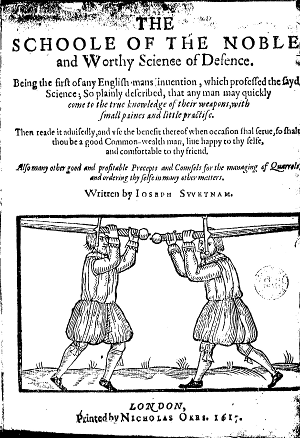A&S
Swetnam Ch. 12 The manners of a passage
This is part of an ongoing project to summarize and provide SCA focused commentary on The Schoole of the Noble and Worthy Science of Defence by Joseph Swetnam, published in 1617.
For links to the other sections of the Swetnam Project please go here.
I am using this facsimile: http://tysonwright.com/sword/SwetnamSchooleOfDefence.pdf for the project.
Here is the third part of this section in Chapter 12.
The manners of a passage.
When making a passing lunge (Swetnam calls this a passage) you must be fast, nimble, and focused. It is a dangerous attack as it brings you very close to your opponents weapon, and is more dangerous the more skilled  your opponent is. To counteract the innate danger in this lunge you must be skillful, have practiced, and have good judgement, especially in knowing where your opponents weapon is. You must make your passing lunge as fast as possible, as soon as you see an opening with your opponents sword high you need to step forward with your left foot quickly, and parry your opponents weapon with your dagger, pushing it up and out of the way at the same time that you attack with your rapier. Your parry and attack must happen at the same time rather than as two actions or it will be too slow. The passing lunge is most effective if your opponent likes to stay in the same guard, but is more dangerous if he moves from guard to guard frequently.
your opponent is. To counteract the innate danger in this lunge you must be skillful, have practiced, and have good judgement, especially in knowing where your opponents weapon is. You must make your passing lunge as fast as possible, as soon as you see an opening with your opponents sword high you need to step forward with your left foot quickly, and parry your opponents weapon with your dagger, pushing it up and out of the way at the same time that you attack with your rapier. Your parry and attack must happen at the same time rather than as two actions or it will be too slow. The passing lunge is most effective if your opponent likes to stay in the same guard, but is more dangerous if he moves from guard to guard frequently.

